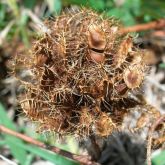Common sensitive plant

Common sensitive plant flowers and leaves
© Manuel Creative Commons

Common sensitive plant habit
© Leonora Enking Creative Commons

Common sensitive plant in lawn
© Leonora Enking Creative Commons

Common sensitive plant pod
© F & K Starr Creative Commons
Native to tropical America, common sensitive plant is a sprawling ground cover with leaflets that close when disturbed.
Common sensitive plant was introduced to Australia as a curiosity plant for gardens. It has since escaped and is now found along the Queensland coast, mainly in wetter areas of the state's tropical north. In these areas, it competes with tropical crops and restricts grazing.
Common sensitive plant is not a prohibited or restricted invasive plant under the Biosecurity Act 2014.
Scientific name
Description
- Sprawling, perennial ground cover plant growing about 15-45cm tall.
- Stems are reddish-brown or purple, round, often woody, with short, curved prickles.
- Leaves are dark green, feathery, fern-like, divided into 1 or more pairs or segments near end of each leaf stalk.
- Leaflets are divided into 10-25 pairs and close up when disturbed or injured.
- Flowers are pale pink or purplish-pink in fluffy balls, 1cm across, on short stalks in leaf forks, developing into clusters of seed pods.
- Seed pods are 2-3cm long, with stiff bristles along edges and 1-5 seeds.
- Seeds are flattened, small, 3mm in diameter.
Habitat
- Prefers disturbed and cultivated areas, such as roadsides, vacant allotments, heavily grazed pastures, crops and lawns.
- Grows on wide variety of soils, and can tolerate shade.
Distribution
- Found along Queensland coast, particularly in wetter areas of tropical north.
Life cycle
- Seeds germinate any time of year but mostly November-March.
- Seeds remain viable for many years.
- Flowering occurs about 3 months after germination.
Affected animals
- Humans
- Livestock
Impacts
Economic
- Competes with tropical crops.
- High plant populations and sharp prickles restrict grazing in tropical pastures.
Social
- Thorns can cause painful wounds.
How it is spread
- Spread mainly by seeds clinging to humans and animals.
Prevention
Control
Physical control
- Chip out individual plants, making sure all root is removed.
Herbicide control
- Herbicides can be effective.
- Thorough wetting of all leaf surfaces is essential. If plants are disturbed before spraying, leaves will fold up and herbicide will be ineffective.
See the Common sensitive plant fact sheet (PDF, 1.1MB) for herbicide control and application rates.
Legal requirements
- Common sensitive plant is not a prohibited or restricted invasive plant under the Biosecurity Act 2014. However, by law, everyone has a general biosecurity obligation (GBO) to take reasonable and practical steps to minimise the risks associated with invasive plants under their control.
- Local governments must have a biosecurity plan that covers invasive plants in their area. This plan may include actions to be taken on Common sensitive plant. Some of these actions may be required under local laws. Contact your local government for more information.